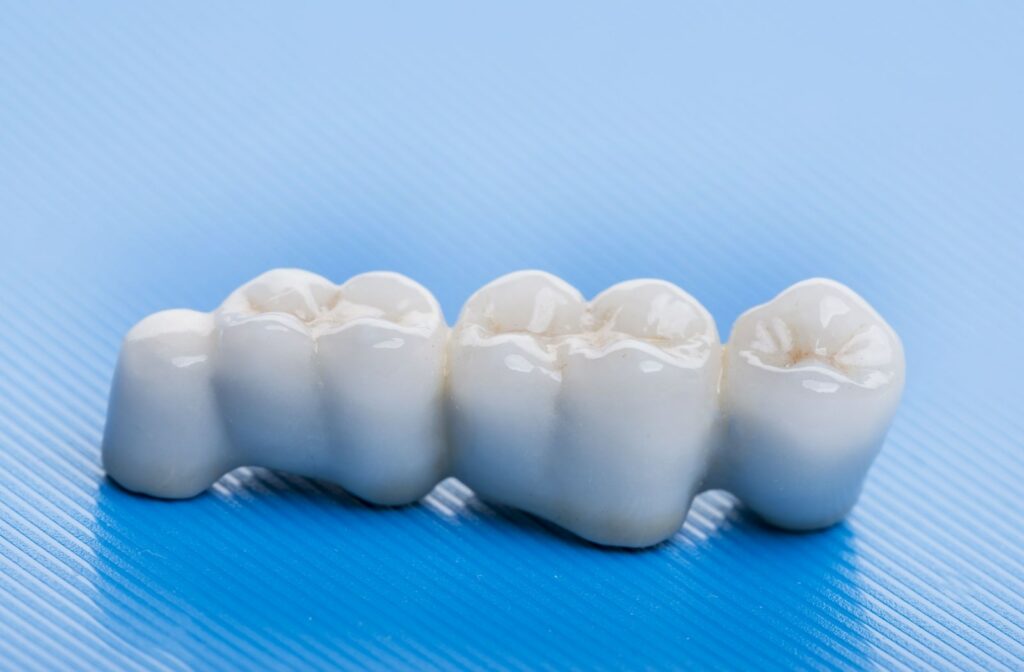Dental bridges have long been a go-to solution for maintaining a healthy and beautiful smile. They are essential for enhancing oral functionality and helping you restore the appearance of your smile. But even with their durability, there may be a point at which a replacement is needed.
Dental bridges can indeed be replaced, and it can be important for your oral health to do so. This blog will explain dental bridge replacements in detail, whether you’re a patient wondering how long your dental bridge will last or an oral health enthusiast wanting to learn more.
What Are Dental Bridges?
It’s important to understand dental bridges before discussing replacement details. Dental bridges are essentially prosthetics used to fill the space left by one or more lost teeth. They can be composed of several materials, such as metal alloys, porcelain, or ceramics, and are secured onto nearby teeth or implants.
In addition to improving teeth’ overall appearance, dental bridges help evenly distribute bite pressures, enhance speaking and eating abilities, and can prevent remaining teeth from moving out of place.
The Importance of Dental Bridges
Dental bridges are crucial for a person’s general oral health and provide an aesthetically pleasing way to restore one’s smile. They preserve the integrity of the mouth and jaw by occupying the spaces left by lost teeth. This helps keep the remaining teeth from shifting and causing an uneven bite.
This can greatly lower the chance of developing dental health concerns like gum disease, biting troubles, and jaw pain. Dental bridges can also increase nutrition and confidence by improving speech and chewing skills.
When You Need a Dental Bridge
If you have lost one or more teeth to gum disease, trauma, decay, or other causes, you may require a dental bridge. This loss can leave a gap in your mouth, impacting your smile and causing functional problems such as trouble speaking and chewing.
A misaligned bite and other dental health issues might result from the remaining teeth shifting out of place due to tooth loss. A dental bridge can efficiently fill in the gap and restore the look and function of your teeth, addressing these concerns.
Factors That May Require Replacement
Several factors can contribute to the need for replacing dental bridges, some of which include:
- Wear and tear: Even with proper care, dental bridge materials can wear over time, leading to a weakened structure that may need to be replaced.
- Oral hygiene and decay: Poor oral hygiene can lead to decay around the bridge’s anchoring teeth, compromising its stability and necessitating a replacement.
- Damage: Accidents or trauma can damage the bridge or the supporting teeth, making replacements unavoidable.
- Aesthetic or functional changes: Over time, changes in your oral health, such as gum recession or changes in the alignment of your teeth, may affect the fit and appearance of your existing bridge, prompting a replacement for both functional and aesthetic reasons.
The Replacement Process
Replacing a dental bridge normally requires several processes that are spread out over several appointments, including:
- Assessment: The first step involves a detailed assessment by your dentist to determine the condition of your existing bridge, the health of the anchoring teeth, and the best course of action.
- Removal: If a replacement is deemed necessary, the next step is to remove the old bridge carefully.
- Preparation: The supporting teeth or implants will be prepared for the new bridge, which may involve reshaping them for a secure fit.
- Impressions: Impressions of your teeth are then taken to custom-design a bridge that perfectly matches your natural teeth’ size, shape, and colour.
- Temporary bridge: In many cases, a temporary bridge is fitted to protect the exposed teeth and gums while the permanent bridge is fabricated.
- Installation: The new bridge is securely bonded or anchored onto the supporting structures once ready.
- Adjustment: Any necessary adjustments are made to provide a comfortable and functional fit.
The Path Toward Your Ideal Smile
Dental bridges are a long-lasting tooth replacement option, although several circumstances could eventually require replacement. Thanks to developments in dental technology and materials, dental bridge replacement is now a simple and effective procedure, allowing you to maintain your attractive, functional, and healthy smile.
If you’re in Hamilton and believe your dental bridge may need replacement, or if you simply wish to learn more about your oral health options, don’t hesitate to contact Upper Gage Dental Centre. Our team is here to guide you through every step of the process.
Taking proactive steps toward maintaining your dental prosthetics contributes to your oral health and helps your smile remain bright and beautiful for years to come.



